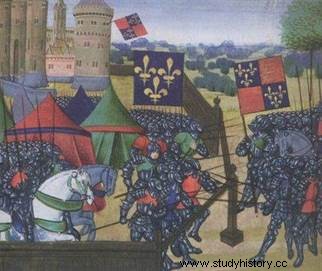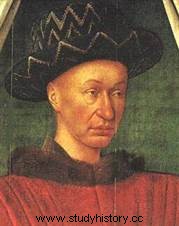 Last engagement of the Hundred Years War, the a Battle of Castillon (July 17, 1453) is a decisive victory for the French royal army won over an Anglo-Gascon army. Multiple defeats, humiliations and scuffles find their conclusion there on the banks of the Dordogne. In 1453, all that remained of the prestigious continental empire constituted by the Plantagenets were only illusions and the rich Guyenne. Henry VI of England has not renounced his claims to the throne of France and Charles VII now wishes to kick them out of the south of the Loire. The small town of Castillon will wash away more than a hundred years of French humiliation in one day.
Last engagement of the Hundred Years War, the a Battle of Castillon (July 17, 1453) is a decisive victory for the French royal army won over an Anglo-Gascon army. Multiple defeats, humiliations and scuffles find their conclusion there on the banks of the Dordogne. In 1453, all that remained of the prestigious continental empire constituted by the Plantagenets were only illusions and the rich Guyenne. Henry VI of England has not renounced his claims to the throne of France and Charles VII now wishes to kick them out of the south of the Loire. The small town of Castillon will wash away more than a hundred years of French humiliation in one day.
Castillon, end point of the Hundred Years War
This Hundred Years War began with a family quarrel that would turn into a dynastic and political quarrel and a dispute over the legitimacy of the kings of France. Indeed, Edward III of England, grandson of Philippe le Bel is removed from the succession in favor of Philippe VI, nephew of Philippe le Bel. In 1334 the King of England declared Philip illegitimate and broke his bond of vassalage with the King of France who had invaded his duchy. The 100 years war thus begins in Guyenne and will end in Guyenne in the small town of Castillon.
 Calais, Crécy, Poitiers, Agincourt, so many masterful defeats suffered by the French armies. A King of France is taken prisoner on the battlefield (John II) and it is the King of England who increases his pressure on his legitimacy to the crown of France. The quest for recognition of the Kings of England will reach its supreme recognition by the infamous Treaty of Troyes negotiated by the Queen of France Isabeau of Bavaria who offers France on a silver platter to Henry VI at the expense of his own son… Charles VII. On July 17, 1453 the infamous Treaty of Troyes and Agincourt will be avenged.
Calais, Crécy, Poitiers, Agincourt, so many masterful defeats suffered by the French armies. A King of France is taken prisoner on the battlefield (John II) and it is the King of England who increases his pressure on his legitimacy to the crown of France. The quest for recognition of the Kings of England will reach its supreme recognition by the infamous Treaty of Troyes negotiated by the Queen of France Isabeau of Bavaria who offers France on a silver platter to Henry VI at the expense of his own son… Charles VII. On July 17, 1453 the infamous Treaty of Troyes and Agincourt will be avenged.
The reconquest of the Duchy of Aquitaine and Guyenne
This July 17, 1453, the battle that begins will also permanently seal the fate of Guyenne and the Kingdom of France. These two entities have had a stormy and conflicting relationship for 300 years. The disputes have their origins in the remarriage of Eleanor of Aquitaine, heiress of the Grand Duchy, with Henri Plantagênet, future King of England Henry II. By separating from Eleanor, King Louis VII of France had deposited the seeds of war and 300 years of instability in the divorce basket.
Indeed, Castillon cannot be reduced to being the last battle of the 100 years war. For 300 years, Guyenne has been the target of French envy jealous of the continental empire of the King of England. Vassal of the King of France to whom he is entitled to swear allegiance, it turns out that he is the largest landowner by his "Angevin" empire. However, France did not have good press in the Duchy because in 1147 and 1148 the Duchy rose up against the French authorities... Eleanor's divorce was therefore welcomed with relief.
 This duchy and principality enjoys enormous privileges and exemptions, and even freedoms. For nothing in the world do the populations agree to ally themselves with France, which would put an end to this very special status. Charles V of France maintains the pressure at the gates of the Duchy and subjects it to looting. Although Bordeaux was the capital in 1451, this did not prevent the population from rekindling the fires of war by opening its doors to the armies of Henry VI of England. The latter instructs Talbot, his general, to lead the operations and cause France to suffer a crushing defeat, opening the doors to the throne. This pious wish and this dream will end in blood and disaster in Castillon.
This duchy and principality enjoys enormous privileges and exemptions, and even freedoms. For nothing in the world do the populations agree to ally themselves with France, which would put an end to this very special status. Charles V of France maintains the pressure at the gates of the Duchy and subjects it to looting. Although Bordeaux was the capital in 1451, this did not prevent the population from rekindling the fires of war by opening its doors to the armies of Henry VI of England. The latter instructs Talbot, his general, to lead the operations and cause France to suffer a crushing defeat, opening the doors to the throne. This pious wish and this dream will end in blood and disaster in Castillon.
The Battle of Castillon
Charles VII, alarmed by the arrival of Talbot and his expeditionary force in Bordeaux, decides to put an end to the occupier and the English claims… and to submit once and for all the turbulent Duchy of Aquitaine. Talbot enjoys an excellent reputation, although it is a tad exaggerated… a military leader of stature but who proves to be incompetent, hesitant in decision-making, the energy to be deployed and above all the opportunities to be seized. To counter the English advance, the King of France dispatches the Bureau brothers with the order to crush Talbot.
The French have 2 advantages… numerical strength and perfect knowledge of the terrain. Talbot engages in this battle to respond to the incessant calls for help from the inhabitants of Castillon who take a dim view of the proximity of the army but also of the French mercenaries and fear their abuses. Talbot and his 4000 men head for the plain of Castillon arriving from the north, that is to say from Libourne.
On July 17, after a first French rout, Talbot was mistaken and firmly believed that the French were leaving the battlefield but also their garrisons... he launched into what he considers a French retreat his few men. He unconsciously forgot the French artillery which sounded its cannonade, alerting the troops retreating from the front. This lightness causes the fall of the English and the death of Talbot. Without a leader and his troops decimated, the surviving English decided to surrender. It is the end of the 100 years war and the end of the English union of Guyenne.
A decisive French victory
The immediate consequences will be the finally achieved unity of the Kingdom of France. This battle and this victory are also the beginnings of the end of the Middle Ages. England will no longer have a continental empire for a long time but will nevertheless remain the mistress of the seas. The Kings of England will not give up their claims, however, because they will not stop approaching the title of "King of France" until the beginning of the 19th century.
Guyenne, incorporated into the kingdom of France, will have its privileges guaranteed… because to preserve it and coax it, the French power will have no choice but to consent to its enormous concessions . Pearl of the English crown, Guyenne will always retain its mistrust of French authority and will open its port and its doors to the English in 1814, announcing the fall of Napoleon.
Bibliography
- Great battles in the history of France, by Bernard Vincent. Southwest, 2014.
- The Hundred Years War, by Georges Minois. Tempus, 2016.
- Charles VII, the reconquest of France, by Ivan Gobry, Tallandier editions, 2001.
- Fields of Honor - Castillon - July 1453. Comics by Gabriele Parma and Thierry Gloris. Delcourt, 2016.
To go further
- The official site of the Battle of Castillon de Castillon
- The site of the town of Castillon-la-Bataille
